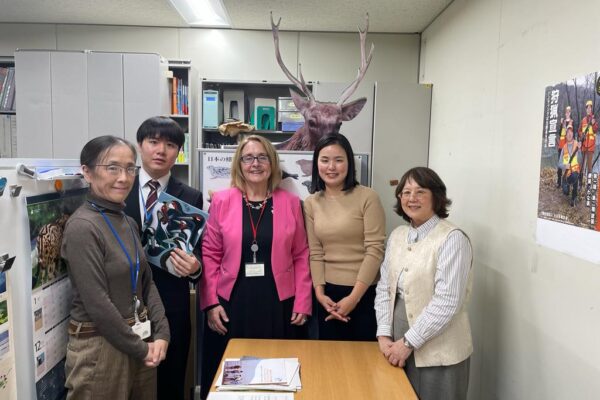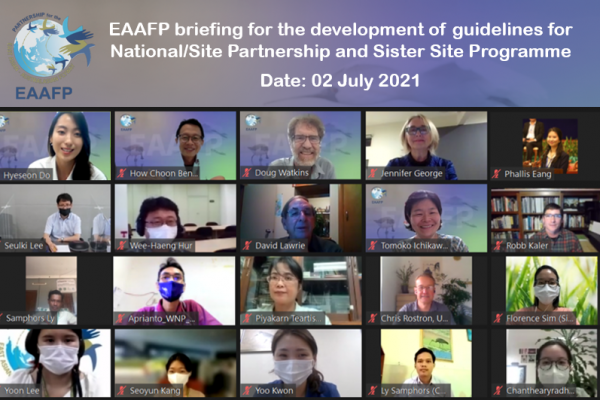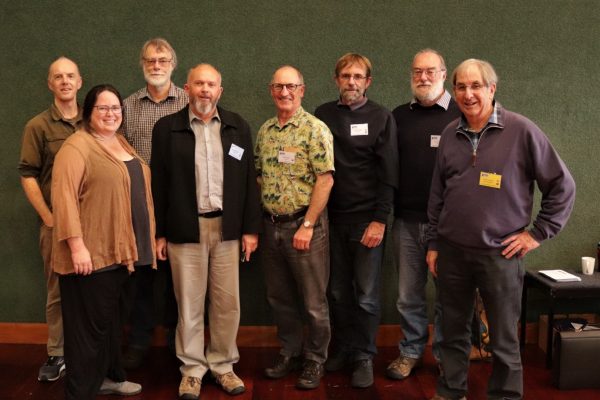-
Japan Showcases National Partnership Strength at EAAFP Meeting
The East Asian–Australasian Flyway Partnership (EAAFP) Secretariat had the honour of witnessing the lively energy of Japan's National Partnership during a hybrid meeting held from December 7 to 10, 2023. This event held special significance for our Chief Executive, Jennifer George, who played a key role in crafting the EAAFP National Partnership Guidelines. Masterfully organised by BirdLife International Tokyo on behalf of the Japanese Ministry of the Environment, the gathering brought together a diverse audience, including high-level representatives from national and local governments, passionate NGOs, dedicated academics and researchers, and hardworking site managers and farmers who engaged in lively discussions and knowledge sharing. The meeting wasn't just about words; it was about experience. A pre-dawn visit to a designated Flyway Network Site offered a breathtaking spectacle—hundreds of geese erupting from the mist, ready for their daily forage. Later, a trip to a local rice farm shed light on the unique challenges and admirable efforts of those striving for both sustainable livelihoods and migratory waterbird conservation. Beyond sharing their own experiences, the Japanese participants generously extended their support to other national partners seeking to develop their own National Partnerships. The Secretariat stands ready to facilitate this knowledge exchange and provide any necessary assistance. The Japan National Partnership meeting wasn't just a gathering; it was a testament to the power of collaboration. It showcased the dedication of diverse stakeholders towards a shared goal—protecting the birds that bind us together across the flyway.
Continue reading -
1st EAAFP briefing for the development of guidelines for National/Site Partnership and Sister Site Programme
1st Webinar Group Photo ©EAAFP Secretariat Starting with the speech of Mr. Robert Kaler, the Chair of EAAFP, the first webinar for Briefing on Development of Guideline/Recommendation for Site and National Partnership and Sister Site Programme was held on 2 July, 2021. Following the Decision 8 and Decision 9 at EAAFP MOP10, the Secretariat has been working with Ms. Jennifer George, project consultant to develop the guidelines strategically and efficiently. It will improve the 1,060 EAAFP FNS relationship among and beyond the network. The following Partners of EAAFP participated in the webinar: 5 Government Partners: Japan, Singapore, RO Korea, United States, Thailand 2 NGOs: New Zealand Miranda Trust and WWT 2 IGOs: ACB and Birdlife (Cambodia) 2 Site Managers from Indonesia Ms. George shared the background and expected outcomes through the guideline development. She highlighted that the FNS flows from relationships, hence securing and strengthening relationships within and between countries is the main purpose of this project. As 1,060 sites are crucial to migratory waterbirds, EAA Flyway holds 149 of those sites which some are twinned as Sister Sites. Ms. George shared the key terms of the guideline: Site Partnership (SP) National Partnership (NP) Sister Site Programs (SSP) Two case studies were presented to share the National Partnership in Japan, and strong Sister Site programs in Singapore. Ms. Tomoko Ichikawa (Presentation file), Ministry of Environment of Japan shared the 3 national networks (Anatidae, Shorebird, Crane), the structure of the NP, and the ongoing meetings in Japan. First, to strengthen cooperation among the Sites, she mentioned that each FNS in Japan belongs to 1 or more of the national networks. Second, she introduced the structure of the NP, where MOE-J carries out activities of the network in coordination with associated organizations. As well as coordinators of each species group network plays a key role publishing newsletters, forming mailing lists, creating Facebook page etc. to exchange information across the national FNS. She highlighted the many meetings well facilitated in Japan, such as the shorebird virtual meeting, the national CEPA WG meeting, the national liaison meeting, and workshops for FNS managers. The effort to share necessary information, encourage and support issues and discussions, and strengthen a cooperative relationship among site managers, local government and NGO all contributes to the excellent NP structure in Japan. Following are some key elements Ms. Ichikawa suggested for a NP: Network species group works well in mobilizing people for active participation and enthusiasm Coordinating cooperative activities Involvement of NGO to secure continuation on past achievements and the implementation of conservation works in the FNS Obtain the understanding of stakeholders by publishing CEPA materials Ms. Ichikawa further proposed some elements for the guideline: Changing the wording from ‘guideline’ to ‘guidance’ or ‘non-binding guideline’ Avoid too detailed and restrictive guideline as establishing a NP depends on the social condition and national stakeholders Highlighting the benefits of a NP The next case study was Mr. How Choon Beng (Presentation link) from National Parks Board, Singapore shared the Sister Site Programs. Sungei Buloh Wetland Reserve at the center of EAAF requires strong justification to secure the space for birds. Mr. How shared Singapore’s approach of regarding the entire population as the stakeholders. Hence, a shared understanding for the stakeholders to view the site as a national heritage, and a habitat for migratory waterbirds is essential. In support of this, Singapore encourages many programs to connect the people, and to enhance the 4 major MOU with China, Hong Kong, Malaysia and RO Korea. The MOU activities diversifies from school exchange, cross promoting other international sites as a tourist spot etc. As well as the MOU expands from sites to various institutions such as National Institute of Ecology, which Singapore held the 1st EAAF Shorebird Science meeting. Mr. How shared the key benefits of exchanging relationship opportunities, such as increasing research opportunities and sharing capacity building. Hence, the following suggestions were made for the SS Program: Strengthening research and management for capacity building Building target groups Utilizing technology to overcome travel and funding barriers Enhancing promotion and publicity Then the panel and open discussion was facilitated by Mr. Doug Watkins, the Chief Executive of EAAFP Secretariat. Mr. Watkins focused the discussion on three points: Defining the term “National Partnership” How to build relationships with other FNS on the Flyway How to develop more Sister Sites A question was raised by Dr. Piyakarn Teartisup, Thailand government partner of EAAFP, with recommendations regarding twinning sites nationally or internationally. Mr. Watkins encouraged to identify common points for linkage such as shared common species. Ms. Ichikawa supported the idea of common species, as Japan’s NP implementation worked best through species group based. Nonetheless, she highlighted the challenge of language barrier, hence initiated the support needed both locally and internationally. Mr. How also shared that a lot of the decisions in linking a Site comes from informal meetings. Such as, during MOP when small group discussions open it gives an opportunity to hear specific issues, challenges, or preferences on other sites. Mr. Terry Townshend, an advisor to the Beijing government on biodiversity, suggested in support of public engagement “to link sites using tracking studies, where individual birds are named by local schools and tracked between sites.” Finally, Mr. Fnu Aprinto, site manager from Wasur National Park Indonesia, shared despite its desire in building a relationship with other FNS there is a limit in the capacity of initiating this as all decision making is done by the Ministry of Environment and Forestry, the central government. Mr. Watkins concluded the open and panel discussion that the EAAFP Secretariat encourages the flexibility of the guideline and supports building strong relationship among sites by capturing he human elements on the shared biodiversity. Hence, in moving forward to articulate an effective and strategic guideline, he welcomed Partner’s suggestions in more depth through interviews that would be arranged by the Secretariat. EAAFP Partners can reach out to us through the contact information here: Ms. Jennifer George, Project consultant: jennifer@snapdragon.co.nz EAAFP Secretariat: secretariat@eaaflyway.net 1st Webinar video recording: Proposed Timeline:
Continue reading -
New Zealand National Partnership Meeting
Bruce McKinley, New Zealand Government At the recent New Zealand Bird Conference representatives from Pukorokoro Miranda Naturalists Trust (PMNT) and
Continue reading -
How to build a site managers network?
Spike Millington, Chief Executive, EAAFP Secretariat I wrote the last introduction of the Newsletter from the World Conservation Congress in Hawaii, and I write this one…
Continue reading -
-
A presentation on Japan’s National Partnership
Read in Japanese (日本語) by EAAFP Secretariat [caption…
Continue reading




